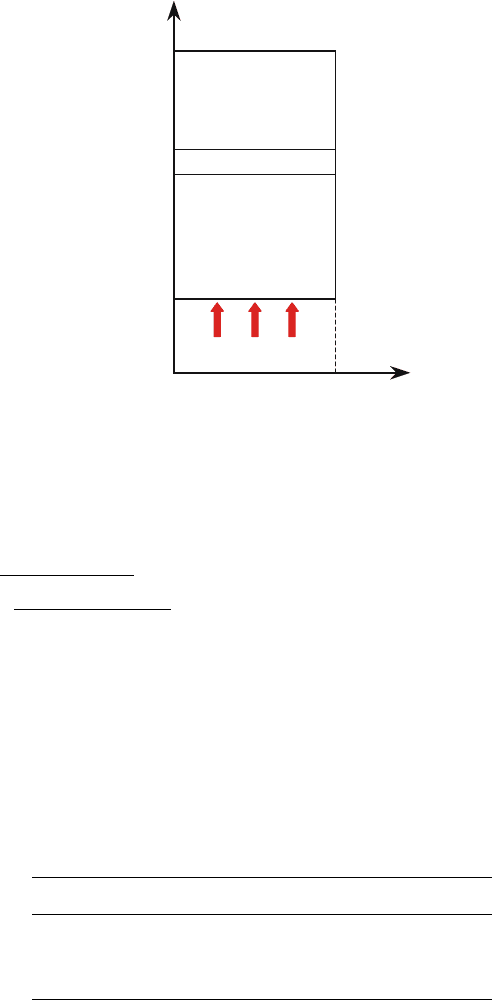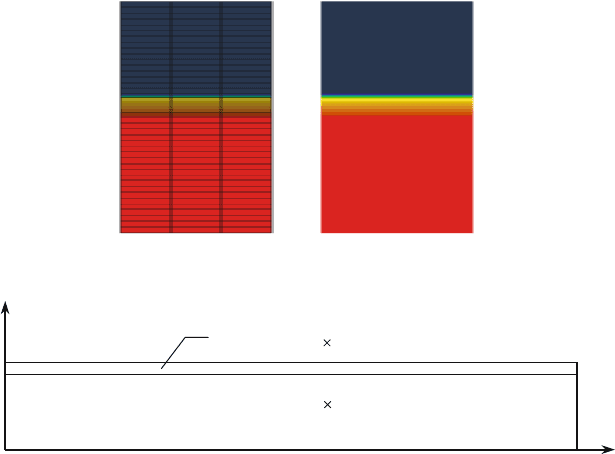Graziani F. (editor) Computational Methods in Transport
Подождите немного. Документ загружается.


438 A.V. Gichuk et al.
and the number of particles resultant from such collisions. With regard to
the transport operator approximation conservativeness, we obtain that the
proposed scheme is balanced both relative to particle transport and relative
to particle collisions.
Of great importance, from viewpoint of substantiation and application, is
the problem of the KM-method stability in time. Such stability can be roved
analytically for some partial cases.
3 MKM-method
In spite of some evident advantages of the KM method, it also has certain dis-
advantages, namely, there is a significant increase in the number of iterations
when numerically solving 2D problems with grid fragmentation in optically
dense physical regions. One of the main assumptions made for the (4) of the
corrector phase is the approximate substitution:
N
j=1
β
ij
s+1
∆ε
(0)
j
≈ 2π
N
j=1
β
ij
s+1
∆ε
j
, (5)
that is valid (to a satisfactory precision) for processes with isotropic or almost
isotropic distribution of particles. In essentially anisotropic cases, the (5) has
to be specified. The implications above caused the development of the MKM-
method.
This method also has two phases, the first of them (predictor) coincides
with (3). The difference between the two methods is in the corrector phase,
where two opposite directions of particle flight (
→
Ω
and
→
Ω
−
) are considered
simultaneously. The second phase equations are:
1
v
i
s+1
∆ε
n+1
i
∆t
+ L
s+1
∆ε
n+γ
i
+ α
i
s+1
∆ε
n+γ
i
=
1
2π
N
j=1
β
ij
s+1
∆ε
(0)
j
+
1
2π
N
j=1
β
ij
⎛
⎝
s+1/2
ε
(0)
j
−
s
ε
(0)
j
⎞
⎠
, (6)
1
v
i
s+1
∆ε
−n+1
i
∆t
+ L
−
s+1
∆ε
−n+γ
i
+ α
i
s+1
∆ε
−n+γ
i
=
1
2π
N
j=1
β
ij
s+1
∆ε
(0)
j
+
1
2π
N
j=1
β
ij
⎛
⎝
s+1/2
ε
(0)
j
−
s
ε
(0)
j
⎞
⎠
. (7)
Here, corrections ∆ε and ∆ε correspond to directions
→
Ω
and
→
Ω
−
,the
same is true for difference transport operators. The mean flux of particles

KM-Method of Iteration Convergence Acceleration 439
in the (7) can be expressed via the right-hand side and the incoming fluxes
through the illuminated faces of a phase space cell. Set the incoming fluxes
equal to zero for the correction function (corrector), this corresponds to the
assumption that fluxes found during the first half-step are used in this phase.
Using the approximate substitution
∆ε
(0)
j
≈ π
∆ε
j
+∆ε
−
j
(8)
from the (6) and (7) and equating the right-hand sides give us the correlation
factors
∆ε
−
i
= A
i
∆ε
i
+ B
i
,
the resultant formula (8) now looks like
∆ε
(0)
j
≈ π ((A
j
+1)∆ε
j
+ B
j
) . (9)
Substitution (9) in the (6) gives us the final form of the second phase
(corrector) of the MKM-method:
1
v
i
s+1
∆ε
n+1
i
∆t
+ L
s+1
∆ε
n+γ
i
+ α
i
s+1
∆ε
n+γ
i
−
1
2
N
j=1
β
ij
(A
j
+1)
s+1
∆ε
n+γ
j
=
1
2
N
j=1
β
ij
B
j
+
1
2π
N
j=1
β
ij
⎛
⎝
s+1/2
ε
(0)
j
−
s
ε
(0)
j
⎞
⎠
, (10)
where A
j
and B
j
can be found by equating the left-hand sides of the (6) and
(7).
The values from the previous iteration are used in the offered version of
the MKM-method to obtain the expression (9) for direction
→
Ω
,sothemethod
becomes non-conservative. There is a way to bypass the problem by solving
the (6) and (7) using the sweep method, however, this way leads to significant
complication the computational algorithm.
4 KM3-method
As it was mentioned above, the practice of using the KM-method shows a
significant increase of the number of iterations during numerical solution of
some classes of problems. For this reason, it becomes necessary to decrease
(subdivide) time steps in order to solve time-depend problems.
For the KM-method efficiency enhancement and further extension of the
range of multidimensional problems that can be solved using this method, its
new version called “KM3-method” is offered in the paper. The main features
of the standard KM-method are preserved in the new scheme construction.

440 A.V. Gichuk et al.
The KM3-method’s specific feature is that it allows solving a three-phase sys-
tem of equations that provides significant enhancement of its cost-efficiency
and less dependence of the number of iterations on the time step value.
Similar to KM- and MKM-methods, KM3-method is constructed using
the predictor-corrector scheme. The (3) is solved in the first phase. The second
phase (corrector) has a more complicated structure, it includes two equations
in which the internal sub-iteration cycle is arranged, namely:
1
v
i
s+1,ν+1/2
∆ε
n+1
i
∆t
+ L
s+1,ν+1/2
∆ε
n+γ
i
+ α
i
s+1,ν+1/2
∆ε
n+γ
i
− l
N
j=1
β
ij
s+1,ν+1/2
∆ε
n+γ
j
=(1− l)
1
2π
N
j=1
β
ij
s+1,ν
∆ε
(0)
j
+
1
2π
N
j=1
β
ij
⎛
⎝
s+1/2
ε
(0)
j
−
s
ε
(0)
j
⎞
⎠
,
s+1,0
∆ε
n+γ
i
=
s+1/2
∆ε
n+γ
i
, (11)
1
v
i
s+1,ν+1
∆
2
ε
n+1
i
∆t
+ L
s+1,ν+1
∆
2
ε
n+γ
i
+ α
i
s+1,ν+1
∆
2
ε
n+γ
i
−
N
j=1
β
ij
s+1,ν+1
∆
2
ε
n+γ
j
=(1− l)
1
2π
N
j=1
β
ij
s+1,ν+1/2
∆ε
(0)
j
− (1 − l)
1
2π
N
j=1
β
ij
s+1,ν
∆ε
(0)
j
,
s+1,0
∆ε
i
=
s+1/2
∆ε
i
,
s+1
ε
i
=
s+1/2
ε
i
+
s+1,ν+1/2
∆ε
i
+
s+1,ν+1
∆
2
ε
i
. (12)
Here, ν is a sub-iteration number with respect to the corrector phase steps,
l is parameter that may be dependent on the space grid’s cell geometry and
the energy group (generalizations to this approach are also possible, where
the angular dependence is assumed as well). If l = const, l ∈ (0; 1). Iterations
in ν can be performed either up to the specified precision achievement (∼10+
20%), or a certain number of times (∼3–5).
5 Test Computation Results
All the methods described above have been verified for radiation transport
problems. The corresponding transport equation system can be easily reduced
to the form (1) as a result of Planck function linearization with respect to
temperature using the energy equation.
KM-method
To demonstrate the method efficiency, the parameters of multiple-group Fleck
problem computations are given below. The problem geometry is shown in
Fig. 2.

KM-Method of Iteration Convergence Acceleration 441
0
1
Z
R
104
102.4
102
100
T=1 keV
16 x 3
16 x 3
20 x 3
Fig. 2. The spectral Fleck problem geometry
The material density in the system is ρ = 1, the material energy depen-
dence on temperature is described by equation E = T . Cross-sections:
χ
si
= 0 is scattering cross-sections;
χ
ai
=
27(1−exp(−ω
i
/T ))
ω
3
i
(optically transparent regions) and
χ
ai
=
10000(1−exp(−ω
i
/T ))
ω
3
i
(optically dense region) are absorption cross-
sections.
The boundary condition “mirror reflection” is specified on the left {Z =
0; 100 ≤ R ≤ 104} and the right {Z = 1; 100 ≤ R ≤ 104} ends. The angular
grid is S
8
quadrature. The mean numbers of iterations in computations with
various time steps during the problem solution using the method of source
iterations and the KM-method are given in Table 1.
The radiation temperature distribution for ct = 30 is shown in Fig. 3.
Table 1. The mean number of iterations per 100 steps
c∆t, cm Source Iterations KM-method
0.03 166.92 11.91
0.15 1907.53 24.82
0.30 3961.35 40.48

442 A.V. Gichuk et al.
Fig. 3. The radiation temperature distribution, ct =30cm
Region 2 (10 100)
Region 1 (10 100)
Z
R
0
10
1
1.2
Fig. 4. The geometry of the test problem with tube
MKM-method
The method was verified using the axially symmetric two-region one-group
problem of a tube which geometry is shown in Fig. 4.
The material density in the system is ρ = 1, the material energy de-
pendence on temperature is described by equation E =0.81 T . Photon ab-
sorption is taken into account in computations, with the photon absorption
cross-section being specified by the formula: χ
a
= A/T
3
. The optically dense
(region 1) and the optically transparent (region 2) regions are specified by
various values of A factor.
A =50.89 in region 1 (optically dense).
A =0.1374 in region 2 (optically transparent).
The absorption cross-section was set equal to zero in computations
(χ
s
= 0). The following boundary conditions with respect to radiation are
specified on the left end of the rectangular region {Z =0;1≤ R ≤ 1.2}:“mir-
ror reflection” for the boundary section belonging to the dense casing and the
incoming isotropic radiation flux corresponding to temperature T = 1 for the
boundary section belonging to the transparent region. The incoming radia-
tion flux was set equal to zero on the upper boundary and the right end.
The results of computations using the standard KM-method and the
MKM-method are compared (see Table 2).

KM-Method of Iteration Convergence Acceleration 443
Table 2. The number of iterations in regions
Number of Iterations
c∆t =0.3cm c∆t =1.5cm c∆t =3cm
Step No. KM MKM KM MKM KM MKM
5 13 23 13 25 31 100 36 93 49 100 61 100
10 12 26 12 26 26 100 31 100 30 100 51 100
15 11 26 11 27 23 93 27 94 18 100 41 100
20 15 25 11 26 14 89 24 83 13 100 30 100
25 10 25 10 27 12 85 21 77 11 100 20 100
30 826102512 8418 731010014 91
35 8 29 9 24 12 77 15 69 8 84 10 79
40 8 31 8 24 11 74 12 64 7 73 7 67
45 8 29 8 24 11 70 11 60 6 55 6 58
50 7 22 8 23 11 66 9 55 5 49 5 46
Table 3. The Number of Iterations in Regions
c∆t =0.3cm c∆t =1.5cm c∆t =3cm
Step No. SI KM KM3 SI KM KM3 SI KM KM3
1 19108 14 14 28696 26 26 26454 35 35
5 3332 24 20 6363 121 88 7960 238 174
10 1559 27 20 8477 101 75 9146 179 135
KM3-method
To demonstrate the method serviceability, the table below (Table 3) gives the
tube problem computation parameters for computations using the method of
source iterations (SI), KM- and KM3-methods. The test problem description
is given above.
A Regularized Boltzmann Scattering Operator
for Highly Forward Peaked Scattering
Anil K. Prinja
1
and Brian C. Franke
2
1
University of New Mexico, Chemical and Nuclear Engineering Department,
Albuquerque, NM 87131, USA
prinja@unm.edu
2
Sandia National Laboratories, P.O. Box 5800, MS 1179, Albuquerque, NM
87185
bcfrank@sandia.gov
1 Introduction
Extremely short collision mean free paths and near-singular elastic and
inelastic differential cross sections (DCS) make analog Monte Carlo and de-
terministic computational approaches impractical for charged particle trans-
port. The widely used alternative, the condensed history method, while
efficient, also suffers from several limitations arising from the use of pre-
computed infinite medium distributions for sampling particle directions and
energies. Accordingly, considerable attention has recently focused on the
development of computationally efficient algorithms that implement the cor-
rect transport mechanics. Fokker-Planck [JEM81] and Boltzmann Fokker-
Planck [CL83] approximations have historically proved very useful in
handling highly peaked scattering in certain classes of problems but these
approaches are limited in the accuracy they can ultimately deliver. A more
general methodology that allows accuracy to be systematically increased
with practically no enhancement of algorithmic complexity has become pos-
sible with the advent of recently proposed higher order Fokker-Planck ex-
pansions [GCP96] and their implementation in so-called Generalized Fokker-
Planck models [LL01,PP01,PKH02]. The goal of these newer approaches is to
approximate the analog transport problem by one which is characterized by
longer or stretched mean free paths and nonsingular collision operators but
which can be solved numerically with considerably less effort than the analog
problem and whose accuracy and efficiency can be readily adapted to a broad
class of problems. One such implementation that has proved particularly ef-
ficient uses purely discrete scattering angle and hybrid discrete-continuous
scattering angle representations [FPKL1, FPKL2]. Moreover, generalizations
of these methodologies to describe energy-loss straggling have been success-
fully demonstrated [PKH02].
Here we describe an angular moment-preserving procedure to regular-
ize the near-singular collision integral for electron elastic scattering by
446 A.K. Prinja and B.C. Franke
approximating and then re-summing what we refer to as a generalized Fermi
expansion. It’s difference from the generalized Fokker-Planck expansion of
Leakeas and Larsen [LL01] will become apparent in the ensuing but we
note here that the advantage of using the formulation developed below is
that the resulting renormalized scattering kernel has a simple and explicit
form which lends itself to a convenient implementation in Monte Carlo sim-
ulations. Furthermore, unlike our recent discrete scattering angle formula-
tion [FPKL1,FPKL2], the present approach is continuous in scattering angle
and consequently is free of ray artifacts. The generalized Fermi expansion is
developed in the next section, followed by a presentation of the regularization
procedure. Numerical results are then presented and the paper closes with
some concluding remarks.
2 Generalized Fermi Expansion
Our approach consists of a modified use of earlier proposed higher-order
Fokker-Planck expansions to describe scattering that is strongly anisotropic
but not sufficiently forward peaked that a strictly Fokker-Planck approxima-
tion can be justified [GCP96, LL01, PP01]. We note that this is invariably
the situation for realistic electron scattering interactions such as described
by the screened Rutherford cross section and its variants, but which never-
theless are near-singular at zero deflection. As will become apparent shortly,
our implementation amounts to approximating the angular diffusion Fokker-
Planck operator, which is just the Laplacian on the unit sphere, by a planar
Laplacian in this higher order expansion and it generalizes a result first due
to Fermi [RG41].
We begin by writing the analog transport equation for the angular flux
ψ(r, Ω) of electrons at spatial position r along direction Ω as
Ω ·∇ψ(r, Ω)=J[ψ],ψ(r
s
, Ω)=δ(1 − Ω
0
· Ω), n · Ω < 0 , (1)
where n is the outward directed unit normal at surface point r
s
and Ω
0
is the
incident beam direction. Also in (1), J[ψ], a linear functional of the angular
flux, is the elastic scattering collision integral, and is given by:
J[ψ]=
4π
σ
s
(Ω
· Ω) ψ(Ω
)dΩ
− σ
s0
ψ(Ω) , (2)
where σ
s
(Ω
· Ω) is the differential elastic scattering cross section (DCS),
µ
0
= Ω
· Ω is the cosine of the scattering angle, and σ
s0
the correspond-
ing inverse scattering mean free path. Energy losses are neglected in the
present investigation but it has been demonstrated before that singular in-
elastic energy-loss operators can also be regularized [PKH02].
Since charged particle interactions are mediated by long range Coulomb
forces, the DCS σ
s
(Ω
·Ω) falls very sharply away from Ω
·Ω = 1, decreasing

Regularized Scattering Operator 447
in a continuous manner by several orders of magnitude over a scattering
angle range of only a few degrees. This has the consequence that an initially
peaked distribution will diffuse slowly in angle with increasing depth into
the material and it enables us to introduce two simplifying approximations.
First, we write
Ω
· Ω ≈ 1 −
1
2
(η − η
)
2
+(ξ − ξ
)
2
, (3)
where η and ξ are the x and y direction cosine components of Ω. Second, we
extend the domain of η and ξ to the open interval (−∞, ∞), a reasonable
step since the angular flux decays rapidly away from the initial direction.
Using these results in (2) gives after some rearrangement
J[ψ]=
∞
−∞
∞
−∞
ˆσ
s
(η
2
+ ξ
2
) ψ(η − η
,ξ−ξ
)dη
dξ
− σ
s0
ψ(η, ξ) , (4)
where ˆσ
s
(η
2
+ ξ
2
) ≡ σ
s
[1 − (η
2
+ ξ
2
)/2]. Our goal is to represent (4) as
a differential expansion and to that end we introduce the two dimensional
Fourier transform pair
¯
ψ(k, l)=
1
2π
∞
−∞
∞
−∞
e
−iK·α
ψ(η, ξ)dηdξ , (5)
ψ(η, ξ)=
1
2π
∞
−∞
∞
−∞
e
iK·α
¯
ψ(k, l)dkdl , (6)
where α(η, ξ)andK(k, l) are angle and transform vectors, respectively, and
K · α =(kη + lξ). Noting the convolution structure of (4), the latter readily
transforms to
¯
J =
¯σ(K
2
) − σ
s0
¯
ψ(k, l) , (7)
where K
2
= K ·K. Here and in the ensuing, appropriate behaviour of ψ and
its derivatives is assumed in order to justify the use of integral transforms.
We further find it useful to express the Fourier transform of the differential
cross section ¯σ(K
2
) as a Hankel transform, namely
¯σ(K
2
)=
∞
0
dλ λJ
0
(Kλ)ˆσ
s
(λ
2
) , (8)
where J
0
(·) is the zeroth order Bessel function of the first kind. Proceeding,
the infinite series representation of J
0
is used in (8) to express ¯σ as an ex-
pansion in K
2
and the result inserted into (7). We next take a formal inverse
Fourier transform of this equation to get, after some considerable algebra,
the desired differential representation of the collision integral
J[ψ]=
∞
n=1
a
n
σ
n
L
n
ψ(η, ξ)=a
1
σ
1
Lψ + a
2
σ
2
L
2
ψ + O(a
3
σ
3
) . (9)

448 A.K. Prinja and B.C. Franke
In the above expression, the a
n
are positive numerical coefficients, L is the
2D planar Laplacian defined by
L≡
∂
2
∂η
2
+
∂
2
∂ξ
2
, (10)
and we have introduced momentum transfer moments defined by
σ
n
=2π
1
−1
(1 − µ
0
)
n
σ
s
(µ
0
) dµ
0
=2
−n
2π
∞
0
dλ λ
2n+1
ˆσ
s
(λ
2
) . (11)
We note in passing that (9), with L replaced by the Laplacian on the unit
sphere, is related, but not identical, to the higher order Fokker-Planck expan-
sion introduced by Pomraning [GCP96] and subsequently used by Leakeas
and Larsen [LL01] to develop a generalized Fokker-Planck approximation for
the scattering integral. If scattering is sufficiently forward peaked, the σ
n
will form a rapidly decreasing sequence and truncation of the expansion in
(9) is suggested. It is especially interesting to consider the approximation to
the collision integral that results from retaining only the first term in this
sequence, namely
J[ψ] ≈
σ
tr
2
∂
2
ψ
∂η
2
+
∂
2
ψ
∂ξ
2
, (12)
where σ
tr
≡ σ
1
is the familiar transport cross section. If, additionally, a thin
target is assumed, throughout which the angular distribution remains nearly
collimated, the resulting transport equation may be simplified to read
∂ψ
∂z
+ η
∂ψ
∂x
+ ξ
∂ψ
∂y
=
σ
tr
2
∂
2
ψ
∂η
2
+
∂
2
ψ
∂ξ
2
, (13)
with boundary condition
ψ(x, y, 0,η,ξ)=δ(x)δ(y)δ(η)δ(ξ) . (14)
This is the celebrated Fermi model, originally derived on physical grounds in
the context of cosmic ray penetration of the atmosphere [RG41] and which
has the following closed form joint Gaussian solution
ψ(x, y, z, η, ξ)=
3
π
2
σ
2
tr
z
4
× exp
−
2
σ
tr
3(x
2
+ y
2
)
z
3
−
3(xη + yξ)
z
2
+
(η
2
+ ξ
2
)
z
!
. (15)
An energy dependent generalization of this result in the continuous slow-
ing down approximation forms the basis of Fermi-Eyges theory that is
widely used but particularly so in electron dose calculations in radiother-
apy [HMA81]. The simplicity of this solution is undoubtedly a very attractive
